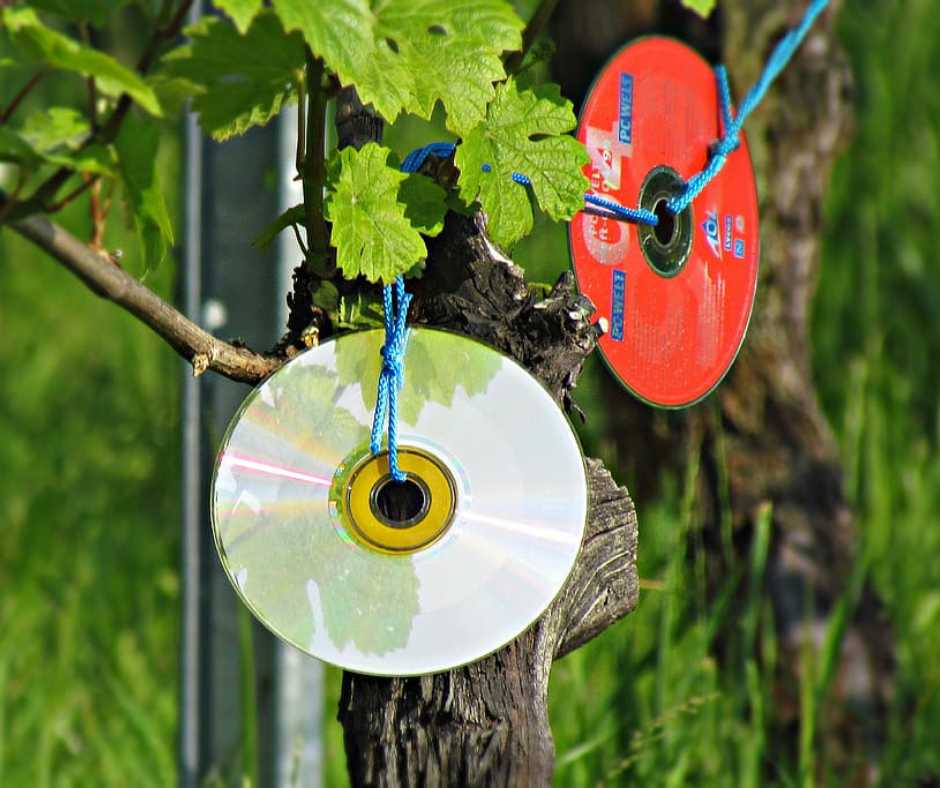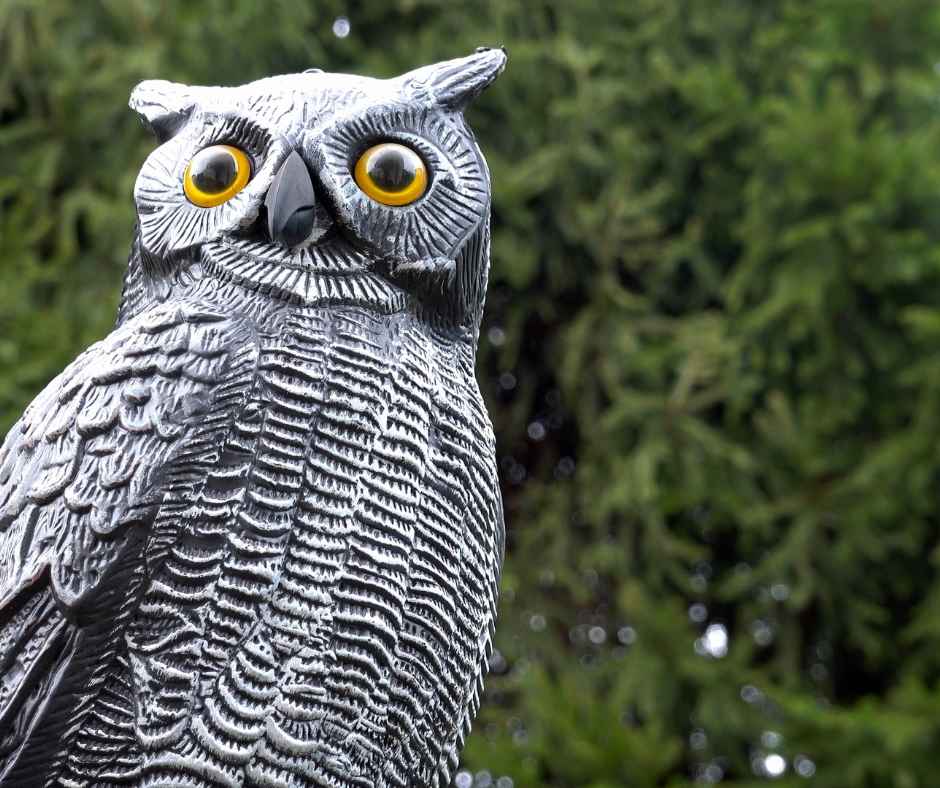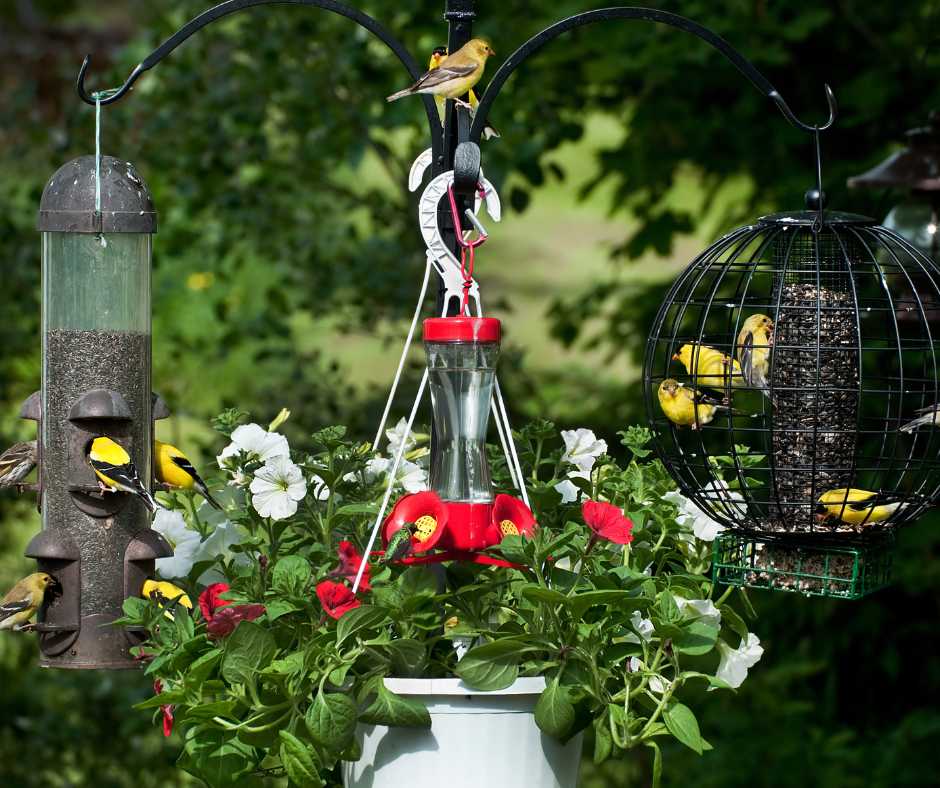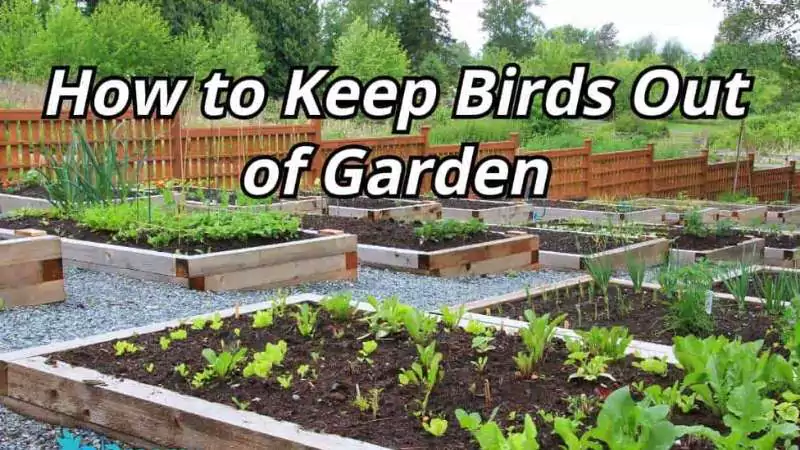Are you wondering how to keep birds out of garden without turning into the neighborhood scarecrow?
To keep birds out of your garden:
- Try understanding their behavior and setting up barriers like netting and garden fleece.
- Use decoys like fake owls and change them often to keep birds guessing.
- Provide alternative food sources like bird feeders away from your garden.
- Keep an eye on what works, and be ready to adjust your methods.
- Remember, it’s about creating a balance where your garden thrives, and birds can coexist without causing harm.
We’re here to dive into a bird-proofing strategy that’s not only effective but also humane and eco-friendly. So, grab your gardening gloves, and let’s explore how to maintain a thriving garden that welcomes visitors of the non-winged variety.
Step 1: Understand and Outsmart Bird Behavior
Getting to know our feathered foes is step one in the garden guardianship guide. Why do birds seem to have a sixth sense about when your seeds are sprouting? Or how do they know the exact moment those juicy tomatoes are ripe? It’s because birds, like us, are creatures of habit and opportunity.
Study Their Habits
Imagine you’re a detective with binoculars in hand, staking the garden. You’ll start to notice patterns. Maybe it’s the early bird catching the worm (or your seeds) at dawn or a late afternoon raid on the berry bushes. Understanding these patterns is like unlocking the secret to their master plan.
Knowing when they visit makes you better equipped to protect your precious plants. Think of it as setting a schedule for your garden defenses based on the birds’ timetable.
Change Deterrents Regularly
Now, let’s talk about strategy. Birds are no birdbrains; they’re observant and adaptable. That fake owl perched like a silent sentinel? They’ll soon twig that it’s as harmless as a garden gnome if it never moves. The key here is surprise and variety.
Mix up your garden’s defense lineup like a coach changing plays in a game. Today, it’s the owl; tomorrow, maybe it’s a snake slithering through the strawberries. And why not throw in some reflective CDs for a garden disco that birds don’t want to boogie down to?
By rotating your scare tactics, you’ll keep those avian invaders guessing and away from your greens.
Remember, it’s not about waging war on our winged visitors but about outsmarting them in a way that keeps both our gardens and the birds safe and happy. After all, a garden is a symphony of life, and every creature, big or small, plays its part.

By understanding and adapting to bird behavior, we create a balance where plants, people, and birds can thrive.
Step 2: Set Up Physical Barriers and Deterrents
Alright, garden warriors, it’s time to build our fortress! But instead of moats and walls, we’re using netting, garden fleece, and some pretty nifty scare tactics. Let’s dive into how to keep those pesky birds from turning our gardens into their buffet.
Install Effective Netting
Imagine netting is like a guard at a party door, keeping out guests we don’t want. When you pick your netting, it’s like selecting the right fishnet – you need holes tiny enough so birds can’t get through but big enough for the good bugs (like bees and butterflies) to come in.
This netting is like a friendly fence, keeping your plants safe without bothering the birds. It’s great for everyone! If you want to learn more about picking the best netting for your garden, the Royal Horticultural Society has some great tips to help you out.

Utilize Garden Fleece
Now, let’s talk about garden fleece, the superhero cape for your plants. This isn’t your average blanket; it’s a lightweight shield that keeps the birds at bay while letting light and moisture whisper to your plants.
Drape it over your veggies like you’re tucking them in for the night, making sure to pin down the edges so it doesn’t take flight with the first gust of wind. Garden fleece is like that cozy, protective barrier that whispers, “Not today, birds.”
Create Dynamic Scare Tactics
And for the main dish, let’s get our craft on with some dynamic scare tactics. Remember those old CDs you’ve got collecting dust? It’s their time to shine – literally. Hang them around your garden, and let them dance in the wind, reflecting light like disco balls gone wild.
Birds see this unexpected garden party and think twice before crashing. And why stop at CDs? Reflective tape, aluminum pie pans, and homemade wind chimes can join the fray. The secret sauce? Movement. These items need to sway, spin, and sparkle, creating a garden that’s a visual no-fly zone for birds.
By using things like netting and other tricks, we’re not just keeping our gardens safe; we’re making everything balanced. We’re making a place where plants can grow well, bugs that help plants can come by, and birds can look from far away (especially if you put a bird feeder way over there).
So, get your netting ready, cover your plants with some warm fleece, and make your garden a place that keeps birds away smartly. Let’s ensure our plants and flowers keep growing strong, all while we get along with nature. Happy gardening, everyone!
Read more: Best Bird Deterrent
Step 3: Employ Natural Predators and Decoys
So, you’ve netted and fleeced your garden, but those birds are still eyeing your veggies like they’re at an all-you-can-eat buffet. What’s next? It is time to call in the reinforcements: natural predators and decoys. Yep, we’re turning the tables and bringing in some faux foes and furry friends to keep those winged diners at bay.
Use Predator Decoys Wisely
Ever thought a plastic owl could be your garden’s knight in shining armor? Well, it’s time to unleash the power of predator decoys. Placing a fake owl or rubber snake in your garden can send those birds flying in the opposite direction.
But here’s the trick: you’ve got to keep them guessing. Like us, birds can get pretty savvy.
They’ll call your bluff if they notice that the owl hasn’t budged an inch in weeks. So, shuffle those decoys around your garden. Today, Mr. Owl is perched on the fence; tomorrow, he’s lurking by the tomatoes. It’s all about the element of surprise.
And remember those terror eye balloons. With their big, spooky eyes, they’re like the garden’s scare tactic du jour. Hang them up, and as they bob and weave in the wind, they’ll have those peckish birds thinking twice before swooping in for a snack.

Introduce Natural Predators
Now, for a more lively line of defense: your pets. If you’ve got a dog or cat who loves the great outdoors, they could be the hero your garden needs. Their presence can be enough to ward off birds looking for a landing spot.
Of course, we’re not suggesting your furry pals go on a bird-chasing spree—their patrol through the garden can make birds think twice. It’s the perfect job for a pet who loves being outside, soaking up the sun, and doing a bit of creeping. Plus, it’s a win-win: they get their exercise, and you get a bird-free garden.
Using fake predators and real animal friends keeps your garden safe and makes the outside world more exciting and fun. It’s like playing a big chess game where you’re the boss, always staying one step ahead of the birds. So, put out your fake predators, let your dog walk around, and see your garden grow without birds messing it up.
Step 4: Distract and Divert with Alternative Food Sources
Have you ever considered tricking those pesky birds away from your precious veggies? It’s like setting up a decoy mission where everyone wins – especially your garden. Let’s dive into how flipping the script on feeding our feathered friends can protect our plants.
Setting Up Bird Feeders
So, here’s the scoop: Placing bird feeders might seem like inviting the enemy into camp, but hear me out. It’s all about location, location, location. Set up a bird buffet on the opposite side of your yard, far from your tender greens and juicy fruits. Think of it as creating a dining area that’s so enticing it keeps the birds too busy to notice your garden.
Opt for seeds that the local birdies can’t resist. Sunflower seeds? Thistle? Give them what they love, and they’ll flock to the feeders instead of feasting on your garden. It’s like throwing a party that keeps them so happy they forget about crashing yours.
Read more: How to Keep Birds Away from Patio

Plant Non-Attractive Flora
Now, onto the greenery. Some plants are to birds what broccoli is to kids – not their first pick. Marigolds, for instance, are the superheroes of the garden. Not only do they brighten up the place with their sunny disposition, but their scent is like a big “Keep Out” sign for birds.
And then there are herbs – lavender, rosemary, and lemongrass – that smell heavenly to us but send birds packing. It’s like setting up an invisible shield around your garden with plants that do double duty: they look and smell significant to us but keep the birds at bay.
For a deep dive into bird-repelling plants, check out this handy guide: Garden Plants That Birds Dislike.
By turning your garden into a less appealing snack bar and offering a more attractive alternative, you’re not just protecting your plants but creating a balanced ecosystem where everyone – plants, birds, and humans – can coexist happily.
So, let’s embrace the art of distraction and diversion. After all, a little cunning and creativity can go a long way in the world of gardening.
Step 5: Evaluate and Adjust Your Approach
Alright, green thumbs and bird watchers, we’ve reached the crucial part of our garden-saving mission: the debrief. It’s time to take a step back, observe, and pat ourselves on the back. But it’s also time to tweak and fine-tune our strategies because, let’s face it, no plan is perfect from the get-go.
Monitor and Modify
Keeping a keen eye on our garden’s dynamics is vital. Did those shiny CDs keep the birds at bay, or did they become the latest garden decor? Are the bird feeders doing their job, or have they become a meet-and-greet for every bird in the neighborhood?
Observation is your best friend here. Moving the decoys to a new spot every few days is more effective, or perhaps adjusting the netting to cover those tempting berries better will do the trick. Gardening is like cooking; sometimes, you must change the seasoning to get it right.

You may also read: How to Keep Birds Away from Pool
Ethical Considerations and Long-Term Coexistence
Now, let’s chat about the bigger picture. Our gardens are more than a plot of land; they’re a piece of the ecosystem we share with birds and other wildlife.
The ultimate goal is to find harmony between deterring birds and inviting their beneficial aspects, like pest control and pollination. It’s about coexisting with nature, not dominating it.
We can protect our plants while offering our feathered friends a safe haven. After all, a garden buzzing with life is a garden genuinely thriving.
So, take a moment to reflect on your garden’s balance. Adjust your strategies not for the sake of your veggies and flowers but with a mindful eye toward the environment. This thoughtful approach turns a garden into a sanctuary for all.
People Also Asked
Will bird feeders attract more birds to my garden?
While feeders attract birds, placing them strategically away from your garden can divert their attention from your plants.
Can I use any netting to protect my garden?
Opt for wildlife-friendly netting with holes small enough to prevent birds but large enough not to trap them.
How often should I move my decoys around?
Aim to relocate or adjust your decoys every few days to a week to keep birds on their toes.
Are there any plants that can attract birds away from my garden?
Yes! Planting a section of your garden with bird-friendly plants and seeds can create an alternative food source for them.
What’s the most important thing to remember when trying to keep birds out of my garden?
Consistency and adaptability. Keep experimenting and adjusting your strategies to find what works best for your garden’s unique ecosystem.
Wrap Up
So, there you have it, folks – your blueprint to keep those pesky visitors at bay while still being the best buddies of our bird pals. It’s about being intelligent, observant, and always ready to switch things up in your garden defense strategy. Remember, our goal isn’t a garden bursting with life (minus the unwanted bird feasts) but one in harmony with nature’s rhythm.
You’re doing more than gardening by learning how birds act, using smart fences and fake birds, giving birds snacks far from your unique flowers, and being ready to change your plan. You’re gardening with nature in mind. Watching, changing, and gardening in a way that’s kind to the earth isn’t great for your plants; it’s also good for the birds and our whole world.
Happy gardening, everyone! May your gardens flourish, birds chirp (from a distance), and your heart is as whole as your harvest. Here’s to creating spaces where every creature, big and small, finds balance and bliss.

